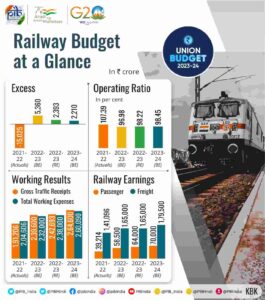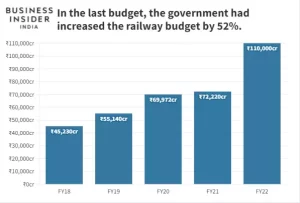In a landmark move, the Indian government’s latest Railway Budget for FY 2024-25 has unveiled a significant allocation for capital expenditure (Capex) aimed at revolutionizing the country’s railway infrastructure. This budgetary decision marks a bold step towards modernizing Indian Railways, which has long been a crucial component of the nation’s transport network. The substantial Capex allocation is expected to catalyze a series of transformative projects and improvements across the railway sector. In this article, we delve into the details of the allocated funds, their potential impacts, and the broader implications for Indian Railways.
Understanding Capital Expenditure in Railway Budget

Capital Expenditure (Capex) refers to the funds spent by an organization to acquire or upgrade physical assets, in this case, infrastructure and rolling stock for Indian Railways. Unlike operational expenditure, which covers the day-to-day costs of running the railways, Capex is focused on long-term investments aimed at enhancing capacity, efficiency, and safety. The Capex allocation for Indian Railways is a critical indicator of the government’s commitment to upgrading railway infrastructure and services. It encompasses investments in new projects, modernization of existing facilities, and procurement of new technology and rolling stock.
Key Highlights of the FY 2024-25 Railway Budget Allocation (Record-Breaking Capex Figures) 
The Railway Budget for FY 2024-25 has allocated a record-breaking sum for Capex, marking a historic high. This unprecedented allocation reflects the government’s strategic focus on revitalizing the railway sector and addressing long-standing issues related to infrastructure and capacity. The exact figure of the Capex allocation stands at ₹2.5 lakh crore, a significant increase compared to previous years.
Major Projects and Initiatives
Infrastructure Upgrades- The budget outlines ambitious plans for upgrading railway infrastructure. This includes the construction of new tracks, modernizing existing tracks, and enhancing station facilities. Key projects include the introduction of high-speed rail corridors and the expansion of metro services in major cities.
Rolling Stock Procurement- A substantial portion of the Capex has been earmarked for the procurement of new rolling stock, including locomotives and coaches. This investment aims to replace outdated equipment and increase the efficiency of train operations. The budget also highlights the acquisition of electric and hybrid trains to support the government’s green energy goals.
Safety and Technology Enhancements- Safety remains a top priority in the Railway Budget. The allocation includes funds for advanced signaling systems, improved safety protocols, and enhanced train control technologies. The integration of cutting-edge technology is expected to significantly reduce accidents and improve operational efficiency.
Impacts of the Capex Allocation

Enhanced Passenger Experience- The infusion of capital into railway infrastructure is set to transform the passenger experience. With modernized stations, improved amenities, and faster trains, travelers can expect a more comfortable and efficient journey. The introduction of high-speed rail services will also cut travel times significantly, making rail travel a more attractive option for both business and leisure travelers.
Economic Growth and Job Creation- The significant investment in railway infrastructure is expected to have a positive ripple effect on the economy. The construction and modernization projects will create numerous job opportunities, boosting employment in the sector. Additionally, improved rail connectivity will facilitate better movement of goods and people, contributing to overall economic growth.
Environmental Benefits- The shift towards electric and hybrid trains aligns with the government’s commitment to sustainability. By reducing reliance on diesel-powered engines, the railway sector will lower its carbon footprint, contributing to environmental conservation. The development of green technologies and practices is expected to set a benchmark for other sectors to follow.
Comparative Analysis with Previous Years
The FY 2024-25 Capex allocation represents a significant increase compared to previous years. In FY 2023-24, the Capex was ₹2 lakh crore, reflecting a year-on-year growth of 25% in the current budget. This sharp rise underscores the government’s determination to address the infrastructure deficit and invest in the long-term future of Indian Railways.
Historical Context- The Capex allocation for Indian Railways has fluctuated based on various factors, including economic conditions and government priorities. However, the current budget’s record-breaking allocation signals a renewed focus on the sector’s modernization and growth.
Future Projections- Looking ahead, the government’s commitment to increasing Capex in the railway sector indicates a strategic vision for the future. With plans for further infrastructure developments and technological advancements, the railway sector is poised for continued growth and transformation.
Challenges and Considerations

While the increased Capex allocation is promising, several challenges must be addressed to ensure the successful implementation of the planned projects.
Project Execution- Effective execution of the numerous projects outlined in the budget will be crucial. Delays and cost overruns have been common in large-scale infrastructure projects, and the government will need to implement stringent monitoring and management practices to mitigate these risks.
Maintenance and Upkeep- Investing in new infrastructure is only part of the equation. Adequate funds must also be allocated for the maintenance and upkeep of existing facilities and rolling stock. Ensuring the longevity and reliability of new investments will be essential for realizing their full potential.
Stakeholder Coordination
Successful execution of railway projects requires coordination among various stakeholders, including government agencies, contractors, and local communities. Effective communication and collaboration will be key to overcoming potential hurdles and achieving project goals.
Conclusion
The FY 2024-25 Railway Budget’s record-breaking Capex allocation marks a pivotal moment for Indian Railways. With a historic investment of ₹2.5 lakh crore, the government is signaling its commitment to transforming the railway sector through infrastructure upgrades, technological advancements, and sustainability initiatives. The anticipated benefits of this investment include enhanced passenger experiences, economic growth, and environmental improvements. However, careful management and execution will be crucial to overcoming challenges and ensuring the successful realization of these ambitious projects. As Indian Railways embarks on this transformative journey, the focus remains on building a modern, efficient, and sustainable rail network that meets the needs of the 21st century.
Check out the following for more information!
- Indian Railway (indianrailways.gov.in) The official website provides detailed budget documents, announcements, and updates directly from the Ministry of Railways.
- Railways News: | The Economic Times (indiatimes.com) Economic Times offers comprehensive coverage and analysis of railway budgets, infrastructure investments, and related economic impacts.
You may like-
Budget 2024: Bold Steps Towards Sustainable Growth Amidst Economic Uncertainty – FINANCE WRITES

